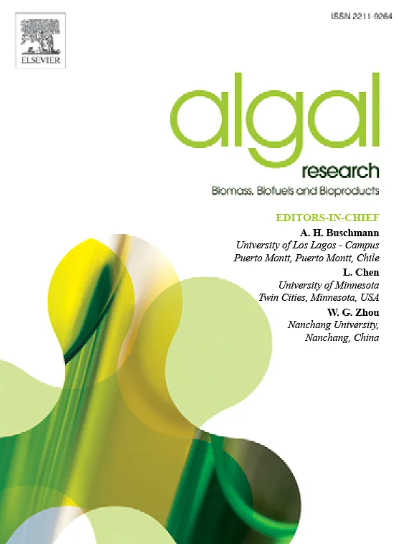In situ monitoring of HCO3−, CO32− and NO3− dynamics during microalgae culture by UV resonance raman spectroscopy
IF 4.6
2区 生物学
Q1 BIOTECHNOLOGY & APPLIED MICROBIOLOGY
Algal Research-Biomass Biofuels and Bioproducts
Pub Date : 2025-05-01
DOI:10.1016/j.algal.2025.104076
引用次数: 0
Abstract
Microalgae can convert inorganic carbon (CO2) and nitrogen (NOx) into biomass products. However, detection of the concentration of inorganic carbon or nitrogen sources under in-situ culture condition is difficult. In this work, taking Dunaliella salina as a model, the concentration of carbon and nitrogen source in microalgae culture systems are real-time and in-situ detected using UV resonance Raman spectroscopy directly without pretreatment. Due to the resonance Raman effect, the detection limit of inorganic components in the culture medium, HCO3−, CO3− and NO3− can reach 10 mM, 2.5 mM, and 0.05 mM respectively. To further indicate the potential of UV Raman spectroscopy, the nitrogen concentration of microalgae culture is monitored using a UV Raman spectrometer at 450 m below the sea. These results demonstrate that the UV resonance Raman spectroscopy is a powerful technique for monitoring the carbon and nitrogen sources for microalgae growth.

紫外共振拉曼光谱原位监测微藻培养过程中HCO3−、CO32−和NO3−的动态
微藻可以将无机碳(CO2)和氮(NOx)转化为生物质产品。然而,原位培养条件下无机碳源或氮源浓度的检测较为困难。本研究以盐杜氏藻为模型,采用紫外共振拉曼光谱法,不经预处理,直接实时、原位检测微藻培养体系中碳源和氮源浓度。由于共振拉曼效应,培养基中无机组分HCO3−、CO3−和NO3−的检出限分别可达10 mM、2.5 mM和0.05 mM。为了进一步表明紫外拉曼光谱的潜力,在海面以下450 m处使用紫外拉曼光谱仪监测微藻培养物的氮浓度。这些结果表明,紫外共振拉曼光谱是监测微藻生长碳氮源的有力技术。
本文章由计算机程序翻译,如有差异,请以英文原文为准。
求助全文
约1分钟内获得全文
求助全文
来源期刊

Algal Research-Biomass Biofuels and Bioproducts
BIOTECHNOLOGY & APPLIED MICROBIOLOGY-
CiteScore
9.40
自引率
7.80%
发文量
332
期刊介绍:
Algal Research is an international phycology journal covering all areas of emerging technologies in algae biology, biomass production, cultivation, harvesting, extraction, bioproducts, biorefinery, engineering, and econometrics. Algae is defined to include cyanobacteria, microalgae, and protists and symbionts of interest in biotechnology. The journal publishes original research and reviews for the following scope: algal biology, including but not exclusive to: phylogeny, biodiversity, molecular traits, metabolic regulation, and genetic engineering, algal cultivation, e.g. phototrophic systems, heterotrophic systems, and mixotrophic systems, algal harvesting and extraction systems, biotechnology to convert algal biomass and components into biofuels and bioproducts, e.g., nutraceuticals, pharmaceuticals, animal feed, plastics, etc. algal products and their economic assessment
 求助内容:
求助内容: 应助结果提醒方式:
应助结果提醒方式:


